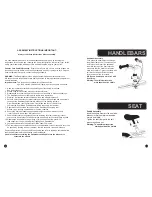
70
b
c
d
a
Note that the bolted connections of the seat post have to be
tightened to the prescribed tightening torques. Use a torque
wrench and never exceed the maximum tightening torque! You
will find the prescribed values in chapter
“Recommended
Tightening Torques”
, directly on the components and/or in
the manuals of the component manufacturers.
Make sure the saddle is not clamped in the curved sections of
the saddle rails
(a)
.
11.3.1 Adjusting Saddle position and Tilt.
With patent seat posts
(b)
a single bolt fixes the clamping mechanism,
which controls both the tilt and the horizontal position of the saddle.
Some seat posts have two bolts for a finer adjustment of the tilt.
Release one or both bolts at the top of the seat post. Turn the bolt(s) two
to three turns anticlockwise at the most, otherwise the whole assembly
can come apart.
Move the saddle forward or backward by sliding its rails in the loosened
seat post clamp. You may have to give the saddle a light tap to move it.
Please observe the markings on the saddle rail.
Make sure the seat of the saddle remains horizontal
(c)
as you retighten
the bolt(s). The bicycle should stand on level ground while you adjust the
saddle.
Retighten the bolt(s) with a torque wrench according to the instructions
of the manufacturer. After fastening the saddle, check whether it resists
tilting by bringing your weight to bear on it once with your hands at either
end of the saddle
(d)
.
Check the bolts by using a torque wrench once a month accor-
ding to the values indicated in the enclosed manuals or directly
on the components.
















































